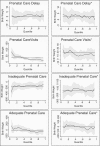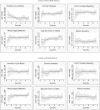Prenatal care effectiveness and utilization in Brazil
- PMID: 19282483
- PMCID: PMC2708921
- DOI: 10.1093/heapol/czp005
Prenatal care effectiveness and utilization in Brazil
Abstract
The impact of prenatal care use on birth outcomes has been understudied in South American countries. This study assessed the effects of various measures of prenatal care use on birth weight (BW) and gestational age outcomes using samples of infants born without and with common birth defects from Brazil, and evaluated the demand for prenatal care. Prenatal visits improved BW in the group without birth defects through increasing both fetal growth rate and gestational age, but prenatal care visits had an insignificant effect on BW in the group with birth defects when adjusting for gestational age. Prenatal care delay had no effects on BW in both infant groups but increased preterm birth risk in the group without birth defects. Inadequate care versus intermediate care also increased LBW risk in the group without birth effects. Quantile regression analyses revealed that prenatal care visits had larger effects at low compared with high BW quantiles. Several other prenatal factors and covariates such as multivitamin use and number of previous live births had significant effects on the studied outcomes. The number of prenatal care visits was significantly affected by several maternal health and fertility indicators. Significant geographic differences in utilization were observed as well. The study suggests that more frequent use of prenatal care can increase BW significantly in Brazil, especially among pregnancies that are uncomplicated with birth defects but that are at high risk for low birth weight. Further research is needed to understand the effects of prenatal care use for pregnancies that are complicated with birth defects.
Figures



References
-
- Abrevaya J. The effects of demographics and maternal behavior on the distribution of birth outcomes. Empirical Economics. 2001;26:247–57.
-
- Anderson P, Doyle LW. Neurobehavioral outcomes of school-age children born extremely low birth weight or very preterm in the 1990s. Journal of the American Medical Association. 2003;289:3264–72. - PubMed
-
- Arias E, MacDorman MF, Strobino DM, Guyer B. Annual summary of vital statistics—2002. Pediatrics. 2003;112 (6 Pt 1):1215–30. - PubMed
-
- Barros FC, Victora CG, Barros AJ, et al. The challenge of reducing neonatal mortality in middle-income countries: findings from three Brazilian birth cohorts in 1982, 1993, and 2004. The Lancet. 2005;365:847–54. - PubMed
-
- Boardman JD, Powers DA, Padilla YC, Hummer RA. Low birth weight, social factors, and developmental outcomes among children in the United States. Demography. 2002;39:353–68. - PubMed
Publication types
MeSH terms
Grants and funding
LinkOut - more resources
Full Text Sources
Medical

